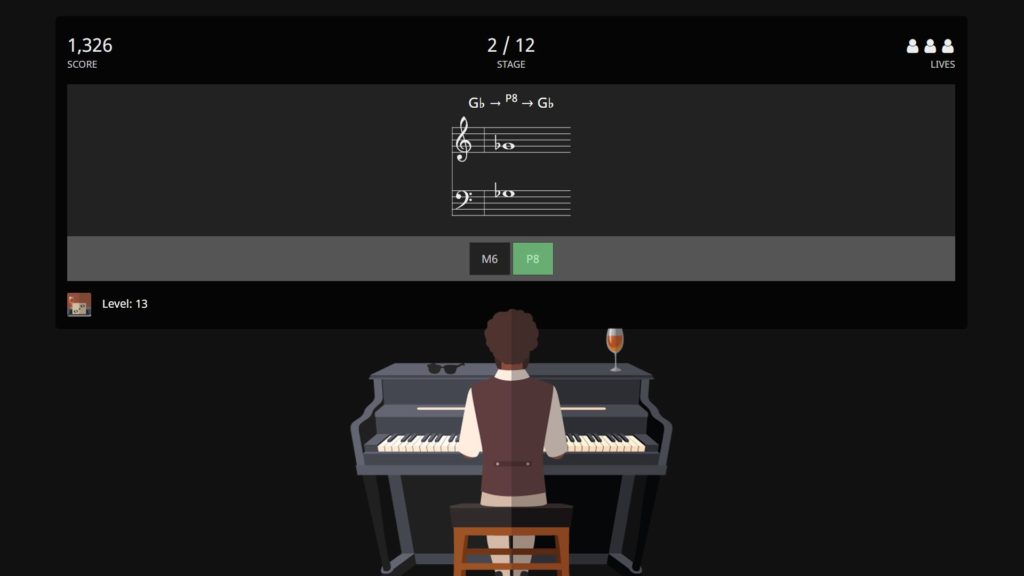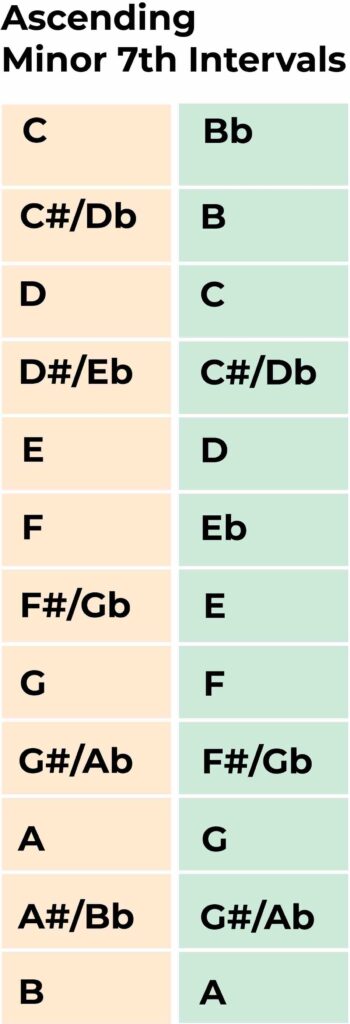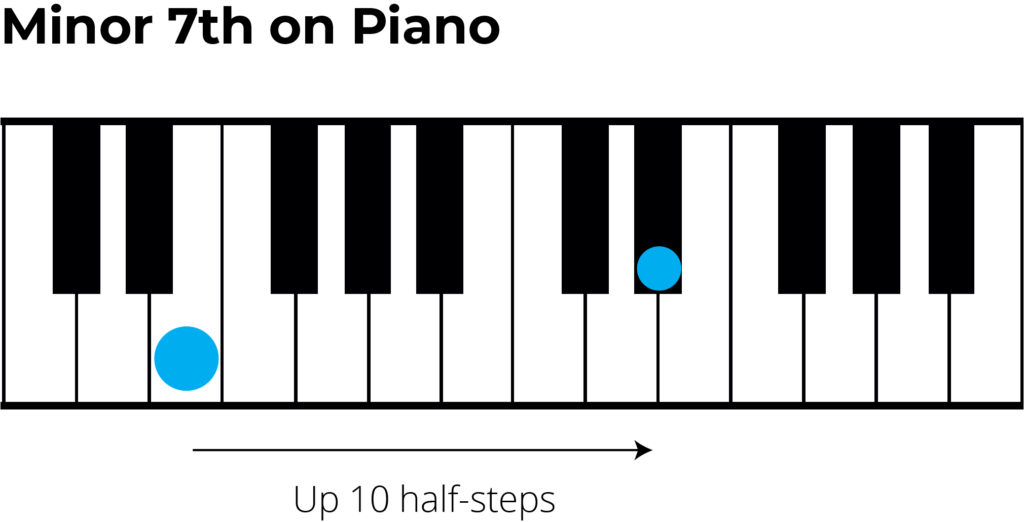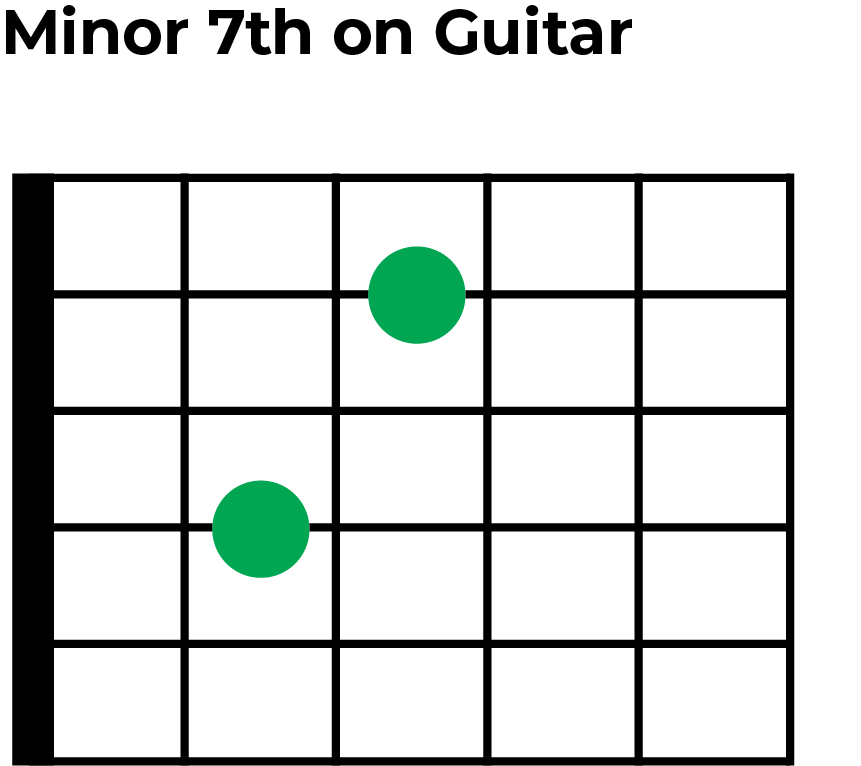As a fundamental building block of music theory, minor 7th intervals can play a significant role in shaping melodies, harmonies, and musical progressions. Whether you’re a budding musician, a music student, or simply curious about the inner workings of music, understanding major 6th intervals is essential for expanding your musical vocabulary.
In this article, we’ll explore the characteristics of the Minor 7th interval, give you examples to listen to and help you recognise it by ear.

Minor 7th Interval Songs
‘Somewhere’ – West Side Story
“Somewhere” from West Side Story is like this beautiful and dreamy ballad that just takes you to another world. It’s all about finding that place of hope and peace amidst the chaos.
The first two notes are a B natural and A natural which make a minor 7th. B – A# would be a major 7th, so by lowering the A a half step we get a Minor 7th.

Star Trek Original Theme
The original Star Trek theme is like the ultimate space adventure anthem that instantly transports you to the cosmos. It’s got that futuristic sound, a sense of epicness, and you can’t help but feel a rush of excitement as it boldly takes you on a journey through the final frontier.
Again is it the first two notes of this piece that give us the minor 7th. C to B natural is a major 7th, so C to b flat is a minor 7th.

‘Can’t Stop’ – Red hot Chill Peppers
“Can’t Stop” by Red Hot Chili Peppers is like an explosive burst of energy that just pumps you up and makes you want to move. It’s got that funky rock sound, catchy riffs, and great vocals too.
The first two notes of the the bass riff give us a minor 7th (E to D). As the can see from the image this resolves to the octave (e natural).

What is a Minor 7th Interval?
Firstly, the definition of an interval is the distance between two notes. We could play the notes at the same time, a harmonic interval, or one of the other, a melodic interval. So how can we describe the distance between two notes.

Using whole steps and half-steps (tones and semitones)
We could describe an interval in terms of the number of half-steps for the lower note to the upper note. For a minor 7th we have to go up 10 half-steps or 5 whole-steps to create the interval.

Using scales to name intervals
Simply put, scales are patterns of half-steps and whole-steps. In the major scale, the 7th degree will be a Major 7th. If we flatten this note by a half-step we will turn it into a Minor 7th.
If we use the Natural minor scale, such as A Minor, we can see that the 3rd, 6th and 7th have been flattened when comparing it to the A Major scale. So if you take the A Natural minor scale, the root to the 7th note will give you a Minor 7th interval.

Ear Training and Intervals
To develop as a musician you’ll want to be able to recognise intervals by ear. This is where ear training comes in, as the more you practice, the better your’ll get.
My recommendation for this is Tonegym as they have a comprehensive and fun program for training your ears. It’s what has gotten the best results with for my own students.
In the ‘tools’ section of their site, Tonegym even have an interval memorizer that allows you to learn every type of interval.
For an in-depth look at ear training, here’s my full review of Tonegym.

Examples of Minor 7th Intervals
Here is a table which shows Minor 7ths across a whole octave. Remember that to name an interval ask yourself, ‘Which degree of the lower note’s scale is the higher note?’


Minor 7th Interval Qualities
We can describe the sound of intervals using a numbers of adjectives. An interval can sound ‘stable’ or ‘grounded’ like a perfect 5th, or it could sound ‘dissident’, ‘neutral’ or even ‘sinister’.
The interval of a minor 7th is a harmonically unstable interval that evokes a sense of tension and mystery. It can be described as a dissonant interval due to its relatively large distance on the musical staff.
The minor 7th interval is often utilized in various musical genres to convey a range of emotions, from introspection and yearning to moments of bittersweetness or introspective contemplation.
How to Identify Minor 7th Intervals by Ear
The best way to start identifying Minor 7th intervals is by listening to reference songs like the ones above. This will give you a reference point to look back at when listening to new pieces.
For a challenge, see if you can spot the Minor 7th intervals in the following pieces.
- ‘Josie’ – Steely Dan
- ‘Chameleon’ Herbie Hancock
- ‘Lady Jane’ Rolling Stones (descending)
- ‘The Shadow of your Smile’ Ella Fitzgerald
ToneGym- The Ultimate Ear Training App
ToneGym allows you to improve your ear with a range of games, interactive and competitions.
Or check out our complete review of ToneGym.

How to Play Minor 7th Intervals on Your Instrument
If you are a pianist then playing a Minor 7th couldn’t be easier. Moving up four and a half whole-steps (9 half-steps) or playing the 7th note of the natural minor scale. Check out the example below.

Minor 7th intervals on guitar are also simply to play. The shape below can be slide up a down the neck to play minor 7th intervals starting and ending in any note.

What’s next….?
- Learn about the Major 7th intervals.
- Expand your interval knowledge with out complete guide to intervals.
